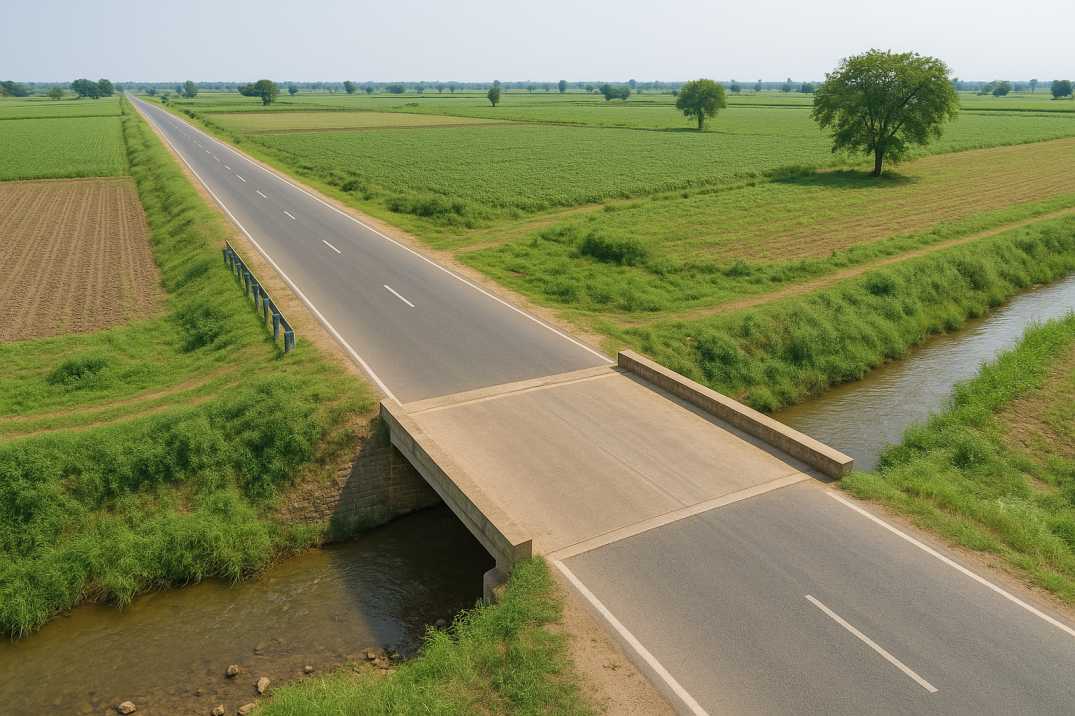Contact Us
RoadVision AI
Private Limited
Office No. 308 & 310, B Block
Ansal Chamber - 1, Bhikaji Cama Place,
Near Engineers India Limited (EIL) Bhawan, New Delhi - 110066
© 2024 | RoadVision AI | All rights reserved
Rural road networks in India play a critical role in improving connectivity, supporting agriculture, and boosting local economies. However, poor drainage remains a major cause of road deterioration. The Indian Roads Congress (IRC) developed IRC SP 50 – Guidelines for the Design of Cross-Drainage Structures in Rural Roads under the Pradhan Mantri Gram Sadak Yojana (PMGSY).
These guidelines ensure that culverts, causeways, and small bridges are designed to handle expected water flows, prevent flooding, and improve the service life of pavements. With the rise of Dashcam-based AI road survey solutions such as RoadVision AI, road agencies now have the tools to monitor drainage performance, detect failures early, and optimize maintenance planning.

Cross-drainage structures (CDS) ensure that water from natural streams or roadside drains crosses the road without damaging the pavement or embankment. According to IRC SP 50 and rural bridge standards in India, effective CDS are essential for:
Culverts are the most common CDS, allowing water to pass beneath the road. Types include:
Suitable for low-traffic rural roads with seasonal water flow. Designed to allow overflow without structural damage.
For larger watercourses where culverts are insufficient, IRC bridge design codes (like IRC 5, IRC 6, IRC 21) are used.
Manual inspections often miss early signs of drainage distress. Modern AI-powered survey tools such as RoadVision AI help in:
As referenced in IRC 82:2015, poor drainage accelerates bituminous pavement distress such as cracking, potholes, and rutting. Proper upkeep involves:
According to MoRTH's Road Asset Management Policy, drainage structures are key inventory assets in road inventory inspections. Proper data collection and AI analytics help:
Cross-drainage structures designed as per IRC SP 50 are critical for sustainable rural road infrastructure in India. They ensure all-weather connectivity, safeguard pavements, and reduce long-term maintenance costs. With the integration of Dashcam-based AI road survey tools, agencies can automate inspection, plan timely interventions, and improve road asset management outcomes.
RoadVision AI is revolutionizing road infrastructure development and maintenance by leveraging cutting-edge AI in road safety and computer vision technology. Through advanced digital twin technology, the platform performs comprehensive road safety audits, enabling early detection of potholes, cracks, and other surface issues, ensuring timely repairs and improved road conditions. It also enhances traffic surveys by providing data-driven insights to address challenges like traffic congestion and optimize road usage. With a focus on building smart roads, RoadVision AI ensures full compliance with IRC Codes, empowering engineers and stakeholders to reduce costs, minimize risks, and improve the overall road safety and transportation experience.
For advanced AI-powered road inspection and predictive maintenance planning, Book a Demo with RoadVision AI.
Q1. What is the main purpose of cross-drainage structures in rural roads?
They allow safe passage of water under or over the road, preventing flooding and pavement damage.
Q2. Which is the most common type of cross-drainage structure in India?
Pipe culverts are widely used due to their low cost, easy installation, and suitability for small streams.
Q3. How does AI improve drainage maintenance in road asset management?
AI-based surveys detect blockages, waterlogging, and erosion early, allowing preventive maintenance before major failures occur.